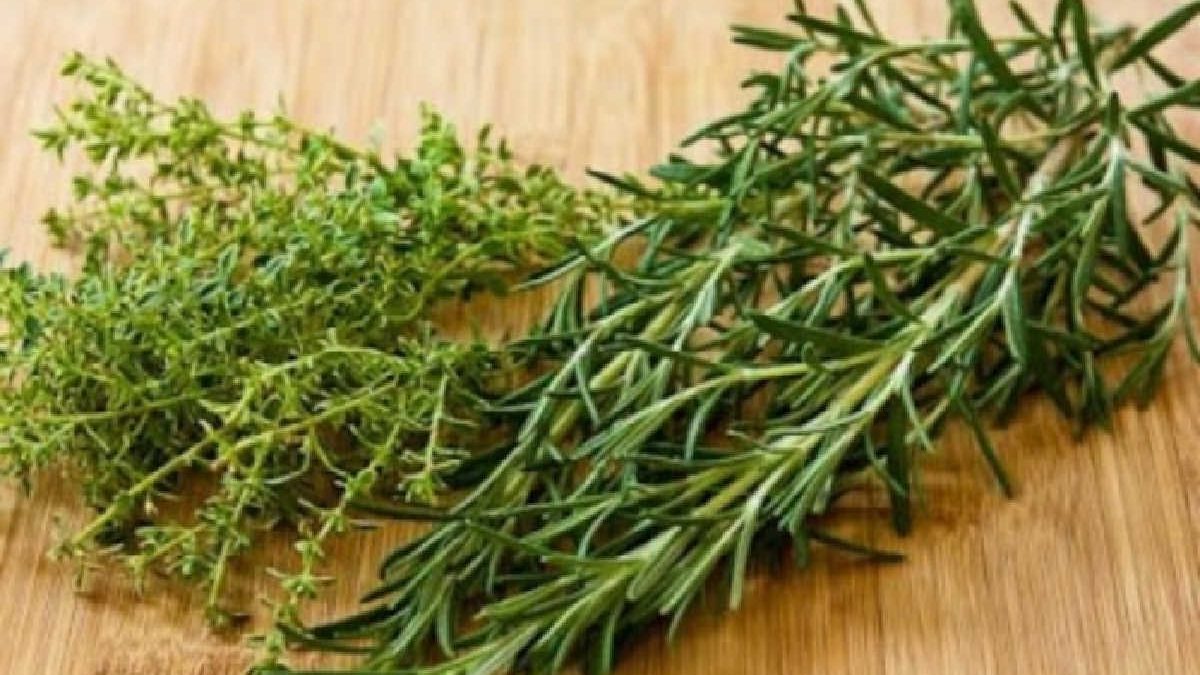Thyme vs Rosemary

Rosemary and thyme are perhaps some of the most popular spicy pairs in the culinary world. Their popularity is all thanks to their dependability in the kitchen, their ability to make your dish tastier and more flavorful than imagined without them. As with everything else both in the cooking world and elsewhere, with popularity comes comparison. That is why we have the rosemary vs thyme comparison that happens everywhere from the kitchen to the dining.
They’re often compared to each other because a few people can’t tell the difference between the two wonderful spices. But at the end of this thyme vs rosemary article, I’ll make sure you’ll fully know them and can tell the differences between them when they are in your food.
What is Thyme?
Thyme is a versatile and aromatic herb that has been cherished by cooks for centuries. With its delicate yet distinct flavor, thyme has found its way into the hearts and recipes of countless culinary enthusiasts. Let’s delve into the captivating world of thyme, exploring its characteristics, culinary uses, and tips for incorporating it into your dishes.
One of the remarkable qualities of thyme is its ability to enhance the flavors of other ingredients without overpowering them. It is often described as having a warm and slightly minty taste, with hints of earthiness. Thyme pairs well with a wide range of ingredients, making it a staple in both savory and sweet dishes.
In savory dishes, thyme is a key component in many classic recipes. It is commonly used to season meats, such as chicken, lamb, and pork, adding a delightful depth of flavor. Thyme is also an essential herb in soups, stews, and sauces, infusing them with its aromatic notes. Additionally, it harmonizes beautifully with roasted vegetables, particularly potatoes and carrots, bringing out their natural sweetness.
When it comes to cooking with thyme, there are a few useful tips to keep in mind. Firstly, fresh thyme leaves are generally preferred over dried thyme as they have a more vibrant flavor. However, if fresh thyme is not available, dried thyme can be a suitable alternative, especially in longer-cooking dishes like stews and braises.
To release the full flavor of fresh thyme, gently crush or chop the leaves before using them in your recipes. This action breaks the cell walls and releases the aromatic oils, intensifying the herb’s taste and fragrance. Thyme is a hardy herb and can withstand long cooking times, making it an excellent choice for slow-cooked dishes where it can infuse its flavors over time.
What is Rosemary?
Rosemary, a fragrant and resilient herb, it is a beloved staple in the kitchen of any experienced cook. Its distinct aroma and robust flavor have earned it a cherished place in countless recipes. Join me as we explore the captivating world of rosemary, from its characteristics and culinary uses to helpful tips for incorporating it into your dishes.
What makes rosemary truly remarkable is its ability to add depth and complexity to a wide range of dishes. Its assertive flavor can be described as piney, resinous, and slightly peppery. Rosemary pairs exceptionally well with ingredients like lamb, poultry, potatoes, and bread, infusing them with its distinctive character.
Just like thyme above, rosemary is a versatile herb that shines in both traditional and modern recipes. It is often used to season roasted meats, such as lamb chops or roast chicken, where its aromatic presence permeates the dish and creates a tantalizing sensory experience. Rosemary is also a key player in Mediterranean-inspired stews, marinades, and hearty soups, adding a robust and fragrant note that elevates the flavors.
When it comes to vegetables, rosemary is an excellent companion. Tossing potatoes or root vegetables with olive oil, salt, and a generous sprinkling of chopped rosemary before roasting creates a harmonious blend of flavors and textures. It also pairs wonderfully with grilled vegetables, enhancing their natural sweetness and adding a touch of herbal complexity.
When using rosemary in your cooking, there are a few tips to consider. While both fresh and dried rosemary can be used, like with thyme fresh rosemary generally offers a more vibrant flavor. To release the essential oils and maximize the herb’s flavor, gently crush the leaves with your fingers or chop them before incorporating them into your recipes.
Since rosemary has sturdy leaves and woody stems, it can withstand long cooking times without losing its potency. This makes it an excellent choice for slow-cooked dishes like braises, stews, and roasts, where it can impart its flavors over time. However, if you prefer a more subtle rosemary flavor, add it towards the end of the cooking process or use it as a garnish.
Thyme vs Rosemary Comparison
Thyme and rosemary are two popular herbs that share some similarities but also have distinct characteristics that set them apart. Let’s compare thyme vs rosemary in terms of their flavor profiles, culinary uses, and growing habits.
Flavor:
- Thyme: Thyme has a delicate yet distinct flavor with warm, herbal notes. It can have a slightly minty, earthy, or lemony taste, depending on the variety. Thyme’s flavor is subtle and doesn’t overpower other ingredients, making it a versatile herb for various dishes.
- Rosemary: Rosemary has a robust and assertive flavor profile. It is known for its piney, resinous taste with hints of citrus and pepper. Rosemary leaves can be quite intense, so a little goes a long way. Its flavor can withstand longer cooking times and adds depth to dishes.
Culinary Uses:
- Thyme: Thyme is a staple herb in Mediterranean and French cuisine. It is commonly used to season meats, such as chicken, lamb, and pork, as well as in soups, stews, and sauces. Thyme pairs well with roasted vegetables, potatoes, and carrots. It is also used in marinades, dressings, and herb blends like Herbes de Provence.
- Rosemary: Rosemary is widely used in Mediterranean and Italian cooking. It is a popular herb for seasoning roasted meats, particularly lamb, beef, and poultry. Rosemary adds a distinct flavor to stews, marinades, and grilled vegetables. It is often used in breadmaking, infused oils, and vinegars. Additionally, rosemary can bring a unique twist to desserts and beverages when used sparingly.
Growing Habits:
- Thyme: Thyme is a low-growing herb that forms compact, bushy plants. It is hardy and drought-tolerant, thriving in well-drained soil and full sun. Thyme can be grown in gardens, containers, or as a ground cover. It spreads easily and can be propagated from seeds, cuttings, or division.
- Rosemary: Rosemary is an evergreen shrub that can grow into a tall and woody plant. It prefers well-drained soil and full sun but can tolerate some shade. Rosemary is more sensitive to cold temperatures and may need protection in colder climates. It can be grown in gardens or containers and propagated through cuttings.
Below is a tabular representation of the differences and similarities that make the rosemary vs thyme comparison a necessary one.
Rosemary vs Thyme Comparison Table
| Features | Thyme | Rosemary |
|---|---|---|
| Flavor | Delicate, warm, herbal, subtle | Robust, piney, resinous, citrus, pepper hints |
| Culinary Uses | Seasoning meats, soups, stews, sauces | Seasoning roasted meats, stews, marinades |
| Roasted vegetables, potatoes, carrots | Grilled vegetables, breadmaking, infused oils | |
| Marinades, dressings, herb blends | Vinegars, desserts (sparingly) | |
| Growing Habits | Low-growing, compact, bushy | Evergreen shrub, tall and woody |
| Hardy, drought-tolerant | Well-drained soil, full sun preferred | |
| Spreads easily, can be propagated easily | Requires protection in colder climates |
Both thyme and rosemary offer unique flavors and aromas that can enhance a variety of dishes. While thyme has a more delicate taste and is often used to complement other ingredients, rosemary has a bolder and more distinctive flavor that can be a standout element in a dish. Ultimately, the choice between thyme and rosemary depends on the desired flavor profile and the specific culinary application. Experimenting with both herbs can lead to exciting and flavorful culinary creations.



